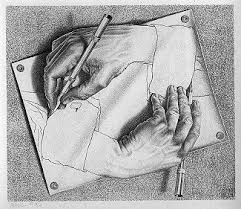Skip to main content\(\newenvironment{mat}{\left[\begin{array}}{\end{array}\right]}
\newcommand{\colvec}[1]{\left[\begin{matrix}#1 \end{matrix}\right]}
\newcommand{\rowvec}[1]{[\begin{matrix} #1 \end{matrix}]}
\newcommand{\definiteintegral}[4]{\int_{#1}^{#2}\,#3\,d#4}
\newcommand{\indefiniteintegral}[2]{\int#1\,d#2}
\def\u{\underline}
\def\summ{\sum\limits}
\newcommand{\lt}{ < }
\newcommand{\gt}{ > }
\newcommand{\amp}{ & }
\)
One of the coolest things in math is infinity. Seems so big, and yet it
turns out that, no matter how big your idea of infinity is, there's a
bigger one! In fact, there are infinitely many different sizes of
infinity. There's an idea to think about, as you drift off to sleep.
The smallest infinity is a countable infinity, the size of the natural
numbers (\(\N\)). Oddly enough, the integers are exactly the same
size! The real numbers \(\R\) however are bigger, by alot. So are the
irrational reals, whereas the rational real numbers are also countable.
So there are some real mysteries in the infinite realm. We know that
infinities get bigger and bigger because of a theorem that says this: The
power set of a set is always bigger than the set itself.
It's easy to show this for finite sets, since the power set \(\wp(B)\)
of set \(B\) of cardinality \(n\) is \(2^n\). And even for the
empty set, of cardinality 0, the power set is bigger (with
cardinality \(2^0=1\)).
Suppose that someone claims that set \(\N\) is the same size (has the
same cardinality) as its power set, \(\wp(\N)\). Then it is possible
to construct a 1-1 correspondence between the sets. Let's prove that
there is no such thing. We'll do a proof by contradiction.
